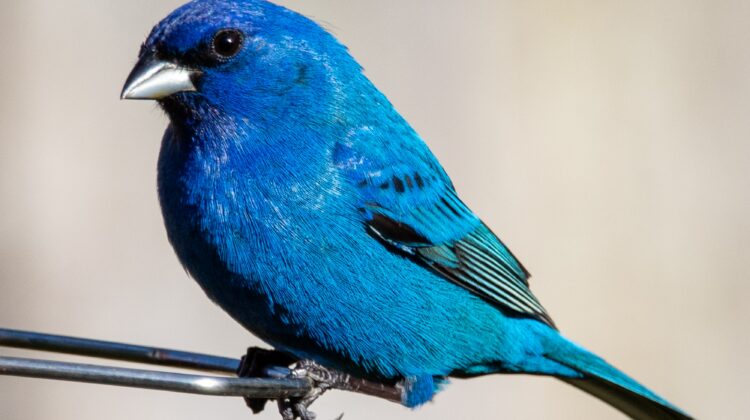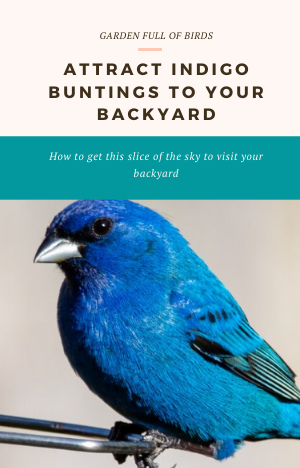
Wondering how to attract Indigo Buntings to your backyard? It’s not surprising a lot of people love the idea of seeing this slice of the sky, as this bird is popularly known, in their gardens. Their bright blue plumage shines in the light in unexpected flashes of blue among the trees and near the feeders, and it’s always a joy to see. Their song, upbeat and just plain happy, differs by region and delights bird lovers everywhere.
A funny fact about indigo buntings is that they learn their song from other males… and improve and create their own versions like a little artist. They however don’t learn their song from their fathers, only unrelated males. This is what creates local and regional songs that evolve over the years, and makes it a bit tricky to identify indigo buntings by song alone.

Are Indigo Buntings Rare?
Many people think indigo buntings are quite rare, but that’s not the case. They are often just very good at camouflaging! They belong to the same family as cardinals and share some commonalities with that type of birds, including their singing abilities.
The male of the species is the one which has the blue plumage and song that makes them popular. Females and younglings are much more muted in color and have no blue (or just a bit in the case of young males). Despite their bright color, they are not easy to spot! You may have indigo buntings in your backyard already… but you aren’t seeing them.
The plumage of indigo buntings is very special: It looks bright blue in the light but it goes nearly black in the shade, allowing them to hide very easily in bushes and branches to avoid predators. This means many people confuse them with blackbirds and other darker birds of similar sizes, and even shoo them away from the bird feeders. The first step to figure out how to attract indigo buntings to your backyard is learning how to tell them apart from other birds to avoid scaring them away by accident.
Look up, they often sing from telephone lines and tall places with a bouncy, happy cadence. Each indigo bunting has a different song.

What Is the Difference Between a Bluebird and an Indigo Bunting?
It’s easy to confuse those two birds, because they are both a very eye catching shade of blue (in the case of the males) and the females look pretty similar. Indigo bunting mature males are totally blue, unlike bluebirds which have an orange chest. Females have a darker chest and throat compared with bluebird females which have a white chest and throat.
How To Attract Indigo Buntings to Your Backyard: Food
Bountings aren’t a very picky bird, they will eat large variety of seeds. Small seeds such as thistle, dandelion or nyjer are favoured, but they also love live mealworms and other worms and even live caterpillars. They also love berries of all kinds. If you re wondering how to attract indigo buntings to your backyard, the answer is: make it easy for them to find the food they like, and they’ll sing in your garden all summer.
In winter, they feed as flocks whereas during the mating season they feed alone. Keep in mind that if your feeder is in the shade, the Indigo Buntings will look a muted black color and are easily confused with other birds. So if you want to enjoy the blue plumage of these slice of the sky birds, make sure the feeder has direct sunlight.
Do Indigo Buntings Use Birdhouses?
The best answer to how to attract Indigo Buntings to your backyards is without a doubt getting a mated pair to nest and breed in your answer. The males will sing to court the females and often will also display their plumage to show off their skill and colors. They tend to be monogamous, and pair for the entire season. A place with good food makes for a good territory, but an Indigo Bunting approved birdhouse just makes it perfect.
A suitable birdhouse for Indigo Buntings need to be placed in shrubs or herb-like plants, close to the ground. It should have a floor surface of 5x5inches, and at least 8 inches tall ceiling inside. The entrance should be between 2 and 10 feet above the ground, and about 1 ¾ -2 ¾ inches diameter.
The breeding season starts in early summer, so if you want to attract Indigo Buntings the nesting birdhouse should be ready by then. The female is the one who selects the nest site, where she will lay 1 to 4 unmarked white eggs on succeeding days right after sunrise. She will incubate for 11 to 14 days, and the chicks will stay with her for less than two weeks at which point they’ll leave the nest.
They love areas near woods and open fields, so if you have a location like that in your garden you are definitely in luck! Sadly they aren’t fond of urban locations, so unless you live in a relatively quiet area of the countryside learning how to attract Indigo Buntings to your backyard may be just a theoretical exercise.
Spotting Indigo Buntings In Your Garden
Provided you live in the countryside, and there are nice spots of woodland or open fields near your garden, spotting this type of bird is not very difficult. Look up at the trees in the sunny patches where the full sunlight will reflect on their feathers to give them that bright blue color that made them be known as “blue canaries“.
If you want to increase your chances of attracting Indigo Buntings to your garden focus on providing the right kind of seeds and possibly live insects and worms on your feeders. A suitable birdhouse for them is a big plus, but if there are suitable natural locations around they’ll happily build their own nests. Just make sure to be silent if you are watching the feeder, as this bird will fly off and disappear into the bushes at the first sign of commotion.
Leave a Reply